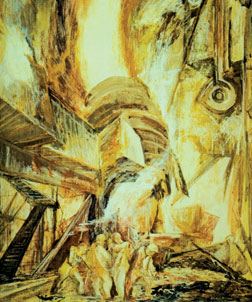Art Exhibition Mounted by Pitt Students Depicts Pittsburgh—Past and Present
 "Bessemer Blowing" by Edward Millman, 1947, gouache on cardboard. From the University’s 1946 Gimbel Pennsylvania Art Collection.
"Bessemer Blowing" by Edward Millman, 1947, gouache on cardboard. From the University’s 1946 Gimbel Pennsylvania Art Collection.Pittsburgh’s transformation from a manufacturing giant to an emerging green, high-tech center has not gone unnoticed. That’s what the organizers of the upcoming SLAG: What’s Left After Industry? exhibition at the University Art Gallery want to illuminate.
The exhibition, conceived and developed by students enrolled in the Museum Studies Seminar in Pitt’s Department of the History of Art and Architecture, will run Nov. 1-29 in the University Art Gallery in the Frick Fine Arts Building.
The students and their instructor, Janet McCall, executive director of the Society for Contemporary Craft, will host an opening reception from 7 to 9 p.m. Nov. 1 in the Gallery. Pittsburgh photographer Mark Perrott, whose images are part of the show, will give an informal talk in the gallery at 7:30 p.m.
SLAG: What’s Left After Industry? seeks to answer its own question by portraying Pittsburgh in three stages: its industrial heyday, during the shuttering of the steel mills, and in its most recent incarnation.
McCall divided her 20 undergraduate students into four independent teams—curatorial, interpretation, installation, and documentation—to contribute to the overall planning and execution of the exhibition, which was built around the University’s 1946 Gimbel Pennsylvania Art Collection, donated to Pitt in 1959 by Gimbel Bros., Inc.
The industrial boom is shown through selected works from the Gimbel Collection, paintings by American artists of factories, mines, and people bound together by Southwest Pennsylvania’s industrial background. For the second phase, the teams used black-and-white photographs taken by Perrott in the early 1980s during the dismantling of the Jones & Laughlin Steel Company’s Eliza Furnace on Pittsburgh’s South Side. The final phase, of contemporary Pittsburgh, is represented in 15 to 20 works submitted by Pitt students and local artists—photography, oil on canvas, fiber, and other media.
“By showcasing a broad range of renderings depicting the construction, deconstruction, and rebirth of Pittsburgh, we expect SLAG to rouse memories of Pittsburgh’s past, provoke thoughts about the present, and open a dialogue about its future,” said Matthew Showman, a Pitt senior majoring in art history and leader of the curatorial team.
During the seminar, students learned about the history of public art museums, ways of thinking about the different types of exhibitions, new models for museums, as well as art-handling guidelines. McCall says the course is giving the students real hands-on experience in museum work, a field that she says is currently in “an identity crisis” but also presenting new opportunities for young people.
“Many baby boomers will be stepping down over the next few years, and there will be a need for well-trained, passionate individuals to continue their work,” McCall said.
For Showman, who hopes to continue his curatorial studies in graduate school, the seminar has been an atypical experience: “Sure, we write papers, but our discourse and intensive discussions about the future of museums and what we want to do as exhibition makers has been really inspiring,” he said.
For more information, call 412-648-2400 or visit www.theslagexperience.info.
Other Stories From This Issue
On the Freedom Road

Follow a group of Pitt students on the Returning to the Roots of Civil Rights bus tour, a nine-day, 2,300-mile journey crisscrossing five states.
Day 1: The Awakening
Day 2: Deep Impressions
Day 3: Music, Montgomery, and More
Day 4: Looking Back, Looking Forward
Day 5: Learning to Remember
Day 6: The Mountaintop
Day 7: Slavery and Beyond
Day 8: Lessons to Bring Home
Day 9: Final Lessons

